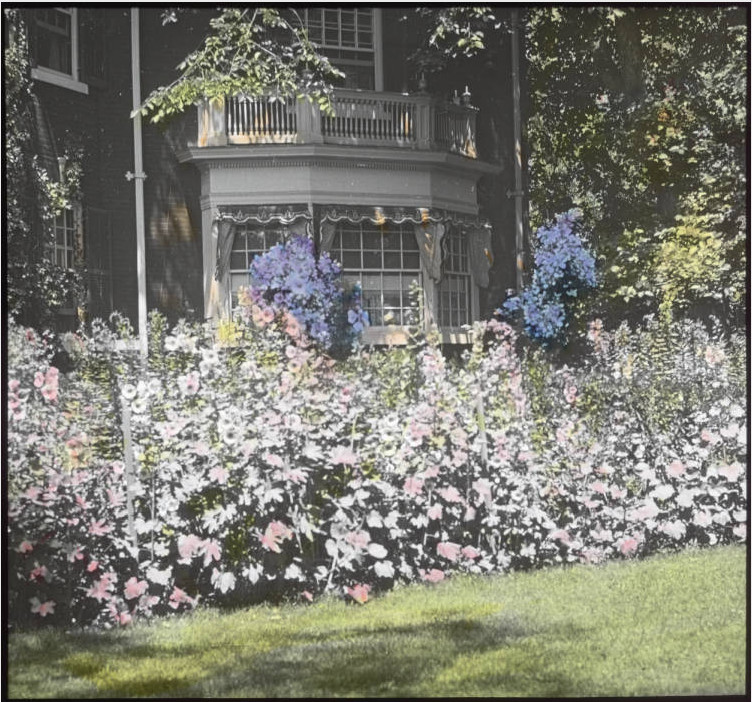Denver Garden Club Lantern Slides

Ten days ago, I was planning to do a blog entry on "Colorado's History of Floods," of which we have many pictures, but recent events have changed my mind. If you want to look at historic flood damage, here are those photos, but this week's blog entry is about something much more pleasant: The Denver Garden Club Lantern Slides.
Though "Lantern Slides" are a 19th century technology, apparently the garden club produced them in the 20s and 30s out of sheer delight with their effect at meetings and other events when projected on the wall of a darkened room. Using photographs by various photographers including L.C. McClure and Edward Milligan, the hand colored glass plates record the gardens of Denver's elite - people who could afford reflecting pools, lotus ponds, elephant fountains, and a personal howitzer/garden ornament.
The Garden Club of Denver was founded in 1916 by Mrs. J. Floyd Welborn, Mrs. J. J. B. Benedict and Mrs. Bradish Morse. During its first year, the club consisted of 23 members who paid dues of $1.00. In 1917, an associate membership formed, which was limited to 20 members. These members did not pay dues or vote, however they were invited to attend flower shows, lectures and other club activities. In 1918, the club adopted its constitution and by-laws and elected the first president of the club, Mrs. Bradish Morse. In 1920, through the efforts of club president, Mrs. Welborn, the Garden Club of Denver became a member of the Garden Club of America.
Garden Club members participated in numerous civic causes and formed partnerships with other nature-related and conservation organizations. In 1922, club members planted and maintained a garden at the Art Museum’s headquarters at Chappel House located at 1300 Logan Street in Denver. In 1939, the club voted to plan, plant and maintain a garden between the Opera House and the Teller House in Central City. In 1948, the U. S. Forest Service and the Garden Club of Denver signed a memorandum of understanding to establish a trail on Mount Goliath. The club continues to maintain the trail.
One of the most significant Garden Club projects was the establishment and development of the Denver Botanic Gardens. The Colorado Forestry and Horticulture Society was the forerunner of the Gardens. Club members belonged to and participated in many of the Society’s activities. The affiliation between the Garden Club and the Society led to the establishment of a botanic garden in Denver. In 1951, the Denver Botanic Gardens became a legal entity with headquarters in the basement of the Denver Museum of Nature and Science (formerly known as the Natural History Museum). In 1954, the club voted to make the Botanic Gardens its main project.
The original gardens consisted of a box canyon garden located in City Park near the Museum of Nature and Science. In 1958, Mrs. James Waring donated money to acquire a new headquarters building through the purchase of 18 acres at York Street and Ninth Avenue. The Gardens moved to that location permanently in 1961. In the 1960s and 1970s the club assumed the planning and installation of the Lobby Court displays, restoration of the Hammer Garden and the development of the Home Demonstration Garden. Since then, the Garden Club has continued to be involved in Denver Botanic Gardens in various capacities.
The Garden Club of Denver financed club activities through a variety of events. The club hosted three “Patio and Garden” sales, four “Flowers and Art” shows held at the Denver Art Museum, floral arrangement and table-setting contests at the Icehouse, other venues which were open to the public and numerous members-only flower shows. In addition to local club activities, members participated in the Garden Club of America’s national and regional meetings. Members interested in landscaping and architecture have enjoyed trips to historic areas of the South and Bermuda.
To this day, the Denver Garden Club continues to be active in gardening and civic events.
The slides to the left are of several different residences, some in Capitol Hill right near the Denver Botanic Gardens, and others are in locations around town. Prominent early Denver names like "George W. Gano," "Henry Swan," "Delos Chapell," and "Verner Zevola Reed" are represented, along with photos of the dramatic "Charlford Estate" in Sedalia, designed in 1926 for Charles Johnson by Burnham and Merrill Hoyt.
The Denver Public Library holds the records of the Denver Garden Club in our Manuscript collection, and you can see the details here.
There are 120 of these lantern slides in the collection, and you can see them here. Be sure and click on the photos to the left to see the larger versions.
And all of the best wishes and comfort to our unfortunate Colorado neighbors who have suffered from the recent terrible flooding.

Add new comment